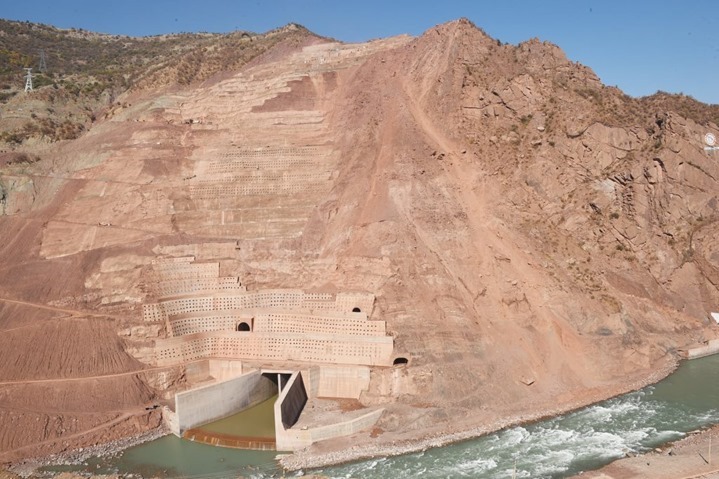
PRESS RELEASE, January 24, 2024.
The fateful and ecologically significant for the whole of Central Asia decision to complete the Rogun hydropower plant on the Vakhsh River in the Amu Darya basin may be made without taking into account the opinion of all stakeholders, in a mode closed from the general public, without correcting the existing shortcomings of the new project, environmentalists warn.
The international environmental coalition Rivers without Boundaries (RwB), together with environmental and human rights organizations working in Central Asia (the NGO Forum on Asian Development Banks and the international Bankwatch Network), has appealed to the leadership of leading international development banks currently considering the possibility of allocating funds to continue construction of the Rogun hydropower plant in Tajikistan, with a strong recommendation to hold public discussions on an updated environmental assessment of the project not only in Tajikistan but also in Uzbekistan, Turkmenistan, Kyrgyzstan and Kazakhstan with the participation of all interested public and scientific organizations to ensure that all suggestions and comments are fully taken into account along with the correction of already identified shortcomings.
Environmentalists and human rights activists recall the large-scale public discussion of the Rogun HPP Environmental Impact Assessment (EIA) in 2014, when the World Bank organized five sessions of public consultations in the capitals of different countries of the region with the involvement of the civil society and scientific community of all Central Asian countries and experts from international organizations. The EIA materials prepared at that time for the hearings are now hopelessly outdated due to changes in natural, climatic, socio-economic, governance and legal conditions, the authors of the appeal note.
“Over the last ten years we accumulated new knowledge about the dynamics of climate change, new factors of impact on the hydrological regime of the Vakhsh River and the entire Amu Darya basin (for example, the construction of the Qosh-Tepa Canal in Afghanistan), as well as new environmental restrictions, for example, the Tigrovaya Balka reserve in the floodplain of the Vakhsh River has become a UNESCO World Natural Heritage property,” recalls Evgeny Simonov, international coordinator of the Rivers without Boundaries environmental coalition. – Even the most superficial analysis shows that potential transboundary impacts of the Rogun hydropower plant are enormous, and their consideration in the new environmental assessment (ESIA) is practically non-existent. Accordingly, it is necessary to discuss them comprehensively at the level of the entire region.
However, according to environmentalists, the exact opposite approach is now being implemented: public discussion is still limited, the publication of the materials of the updated socio-environmental assessment has taken place without broad notification of stakeholders, and no plan or schedule for public consultations on the draft ESIA with members of the public and experts from other Central Asian countries has been presented.
“The Rogun hydropower project itself is of great concern because of the enormous social and environmental risks associated with it, not only for Tajikistan but for the region as a whole,” says Alexander Kolotov, Central Asia coordinator for the Rivers without Borders environmental coalition. – But the situation is also aggravated by the completely closed, behind-the-scenes approach to project approval: in fact, only local officials, foreign bankers and pro-government experts are now involved.”
The damming of the Vakhsh River by the Rogun hydropower plant will result in the formation of a reservoir with a total area of 170 km² and a length of about 70 km. Forced resettlement from the flood zone will affect more than 40,000 local residents. International development banks, led by the World Bank and the Asian Infrastructure Investment Bank, are now considering the allocation of more than 600 million US dollars for the next stage of the project, while the World Bank estimates that the completion of the Rogun HPP will require more than 6 billion US dollars.
The Rivers without Boundaries Environmental Coalition (RwB) is an international network of non-governmental organizations and experts working to protect transboundary rivers and promote best practices in river basin management. The coalition was formed in 2009, in 2011 the Mongolian branch of the organization was registered in Ulaanbaatar (Mongolia) under the name “Khil Khyazgaarguy Gol Moron” (Rivers without Boundaries), in 2023 the coalition established a public foundation “Shekarasyz Ozender” (“Rivers without Boundaries”) based in Almaty (Kazakhstan) to work in Central Asian countries.
The website of the coalition’s Central Asia project is https://rivers.help/.
Link to the updated Rogun HPP Project Socio-Environmental Assessment (only Volume 1 and Volume 3) as of 19.01.2024: http://www.energyprojects.tj/index.php/ru/rogunskaya-ges/eko-sots-instrument (in Russian and English). ESIA documents are not available in Tajik language.
The current version of Volume 2 of the ESIA, which should contain details of the completed social and environmental assessments of the project , remains unavailable to the public, as well as other critical documents to be disclosed with the EIA: the Biodiversity Management Plan, Environmental and Social Commitment Plan (ESCP), Stakeholder Engagement Plan (SEP) and Grievance Redress Mechanism (GRM), Resettlement Policy Framework (RPF) and specific plans for resettlement of residents from the flood zone.
Contacts
International Coordinator of the Rivers Without Boundaries Coalition, Chief Specialist of the PF “Rivers Without Boundaries”, Dr. Eugene Simonov:
– email: coalition@riverswithoutboundaries.org

